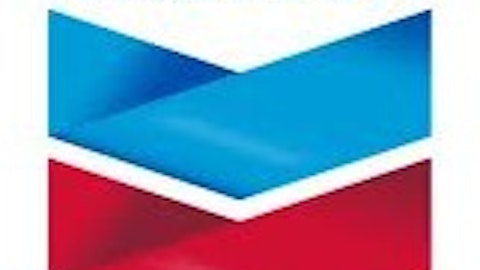
On a recent conference call, Core Laboratories N.V. (NYSE:CLB) CEO David Demshur stated that outside some of the best spots in the US, oil producers in the US will slow down exploration if oil prices are to remain below $90 for a sustained amount of time. Let’s look at a few factors that might give some credence to Mr. Demshur’s claim.
1. Higher resource costs. According to Chesapeake Energy Corporation (NYSE:CHK) the average shale well in the US is drilled to 7,800 feet vertically plus several thousand feet horizontally and is injected with over 5 million gallons of water, sand and chemicals to fracture the tight pores where oil is hidden. All of this effort is for an average initial production rate of about 450 barrels per day.
All of that extra work to tap a well translates into using resources, a lot of them. The list of requirements for a new well is so staggering, even the price of food products can affect how much it costs to drill a well. in Q2 of 2012, Halliburton Company (NYSE:HAL) took a big hit on earnings because the company overspent on guar gum, a thickening agent it needs for fracking fluids. When all of these kinds of costs are added up, the average well in the US today costs about $6 to $11 million dollars.
It’s plain and simple, money just doesn’t go as far as it used to. According to a report by Barclays, spending in the exploration and production sector increased 19% and 11% in 2011 and 2012, respectively. Over that time period, output only increased 0.1% in 2011 and 2.2% through first 10 months of 2012. The increased costs to get marginal results back will ultimately result in higher prices.
2. Location, location, location. To add insult to injury, these higher costs are compounded by the fact that the places where we are finding oil are remote, hard to reach locations. Whenever a company ventures off into one of these remote locations in search for oil, it is a higher risk situation that involves a lot of costs.
There are two great examples of these kinds of sources just North of the US: Alaskan offshore and Canadian oil sands. These two regions have been giving exploration and production companies headaches for years. Royal Dutch Shell plc (ADR) (NYSE:RDS.A) has spent $5 billion over the past 5 years trying to tap a potential source in the Chuckchi Sea off of Alaska, and so far they don’t have a drop to show for it. Also, because of high costs and slumping prices, several producers are shelving plans to build out Canadian oil sands, with French giant Total taking a $1.6 billion loss to completely walk away from the project.
What makes these projects unattractive? The break-even costs. A Wood Makenzie study recently showed that the break-even cost for a new Canadian oil sands project is between $65 and $100 per barrel, depending on the type of extraction. Add transportation and a rate of return, and these projects don’t make economic sense unless oil prices are high.
3. Taxes and regulation. It costs a pretty penny to do business in the oil and gas space. According to the EIA, about 11% of the price of a gallon of gas foes to federal, state, and local taxes.

Source: US Energy Information Administration.
If the recent budget proposal from the Obama administration were to pass as is, though, that could change. The additional taxes and fees for the industry could total as much as $90 billion over the next 10 years. Its very unlikely that oil companies will be happy to let these additional taxes eat into profit, so we will most likely see an uptick in oil if these proposals were to be enacted.
You also have to take into account regulation, safety, and liability costs. According to a report by Lux Research, oil companies pay about $0.70 per barrel of oil on safety regulations, but that could be going up. The industry is expected to spend an additional $21 billion over the next 20 years. What is more expensive, though, is the liability of cleaning up a spill. It is estimated that the liability costs for cleaning up a spill is about $8,000 per spilled barrel.
Much of the public demands that oil and gas drilling be safer, but we will have to be willing to shoulder higher oil prices if we expect oil companies conduct their business in a safer, more environmentally friendly way.
The article 3 Factors Keeping Oil Above $90 a Barrel originally appeared on Fool.com and is written by Tyler Crowe.
Fool contributor Tyler Crowe has no position in any stocks mentioned.You can follow him at Fool.com under the handle TMFDirtyBird, on Google +, or on Twitter, @TylerCroweFool. The Motley Fool recommends Halliburton and Total SA. (ADR). The Motley Fool has the following options: Long Jan 2014 $20 Calls on Chesapeake Energy (NYSE:CHK), Long Jan 2014 $30 Calls on Chesapeake Energy, and Short Jan 2014 $15 Puts on Chesapeake Energy.
Copyright © 1995 – 2013 The Motley Fool, LLC. All rights reserved. The Motley Fool has a disclosure policy.


